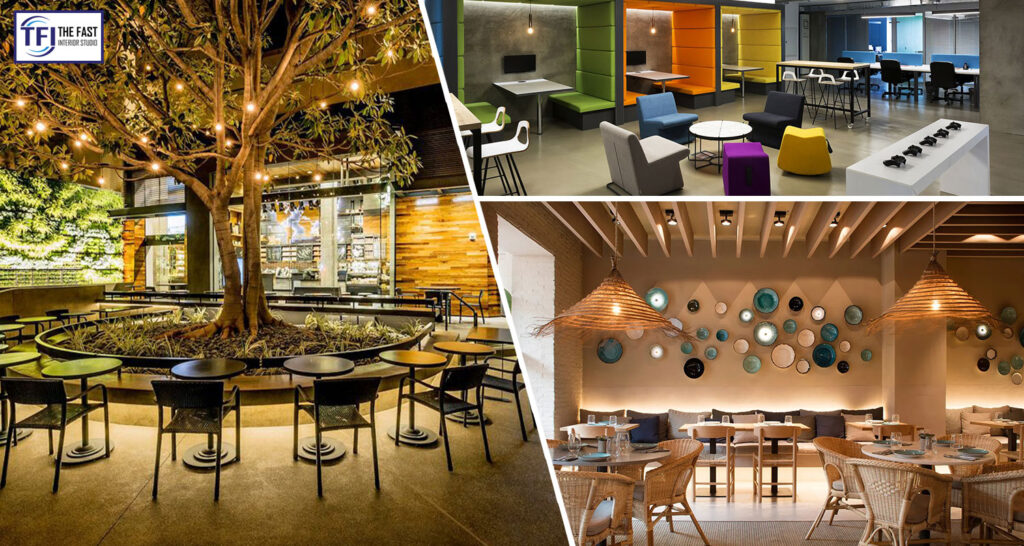Merging Aesthetics and Functionality in Restaurant Design & Ambience

In the realm of restaurant design, the interplay between aesthetics and functionality is a delicate dance, creating spaces that not only please the eye but also serve a purpose. A well-designed restaurant interior can elevate the dining experience, making customers feel not just satisfied but immersed in a carefully curated atmosphere. Let’s delve into the art of merging aesthetics and functionality to unveil the secrets behind successful restaurant design. Creating a Visual Feast: The Aesthetics of Restaurant Design When patrons step into a restaurant, the first thing that captivates them is the visual appeal. Aesthetics play a crucial role in setting the tone and creating a memorable impression. From the color scheme to the furniture choices, every element contributes to the overall ambiance. Choosing the Right Palette: The restaurant’s color palette is like a canvas that sets the mood. Warm tones like reds and oranges evoke a cozy, intimate atmosphere, while cool blues and greens create a refreshing and modern feel. Striking the right balance is key. Furniture as Art: Restaurant interior design isn’t just about tables and chairs; it’s about functional art. Furniture should not only complement the overall theme but also provide comfort. Elegant and comfortable seating encourages guests to linger, enjoying their dining experience. Lighting Magic: Lighting is the unsung hero of restaurant decor. The right lighting can highlight architectural features, create intimacy, and even influence appetite. Whether it’s pendant lights, wall sconces, or ambient lamps, each fixture plays a role in sculpting the desired ambiance. Functionality: Where Form Meets Purpose Aesthetics alone, however, do not make a restaurant successful. Functionality is equally crucial, ensuring that the space is not only beautiful but practical for both customers and staff. Flow of Space: A well-designed restaurant considers the flow of space. From the entrance to the seating area and the restrooms, each section should seamlessly connect, allowing for easy navigation. This not only enhances the customer experience but also improves operational efficiency. Optimizing Seating Arrangements: The arrangement of tables and chairs is a critical aspect of functionality. Adequate spacing ensures that guests don’t feel cramped, and servers can move efficiently. Balancing intimacy with capacity is the key to maximizing the use of space. Kitchen Efficiency: Behind the scenes, the restaurant interior design extends to the kitchen. An efficiently designed kitchen layout can enhance productivity, minimize wait times, and contribute to the overall success of the establishment. Harmony in Design: The Intersection of Aesthetics and Functionality The magic of restaurant design lies in achieving a seamless harmony between aesthetics and functionality. It’s not about choosing one over the other but finding a perfect balance that enhances the overall dining experience. Theme Integration: A well-thought-out theme can bring together the aesthetic and functional elements. Whether it’s a rustic farmhouse feel or a sleek modern vibe, the theme should be reflected not only in decor but also in the layout and operational aspects. Branding through Design: Restaurant design is a powerful tool for branding. Consistent aesthetics across multiple locations create a recognizable brand identity. From the color scheme to the choice of materials, every detail contributes to building a cohesive brand image. Adaptability for Success: The restaurant industry is dynamic, and successful designs embrace adaptability. Flexibility in layout and decor allows restaurants to evolve with changing trends and customer preferences, ensuring long-term success. Conclusion: Elevating the Dining Experience In the world of restaurant design, the merging of aesthetics and functionality is an ongoing process. It’s about creating spaces that not only captivate the eye but also enhance the overall dining experience. From the careful selection of colors and furniture to the thoughtful consideration of space and efficiency, every element plays a vital role. As the restaurant industry continues to evolve, the importance of finding that perfect balance between aesthetics and functionality remains at the heart of successful restaurant design.

